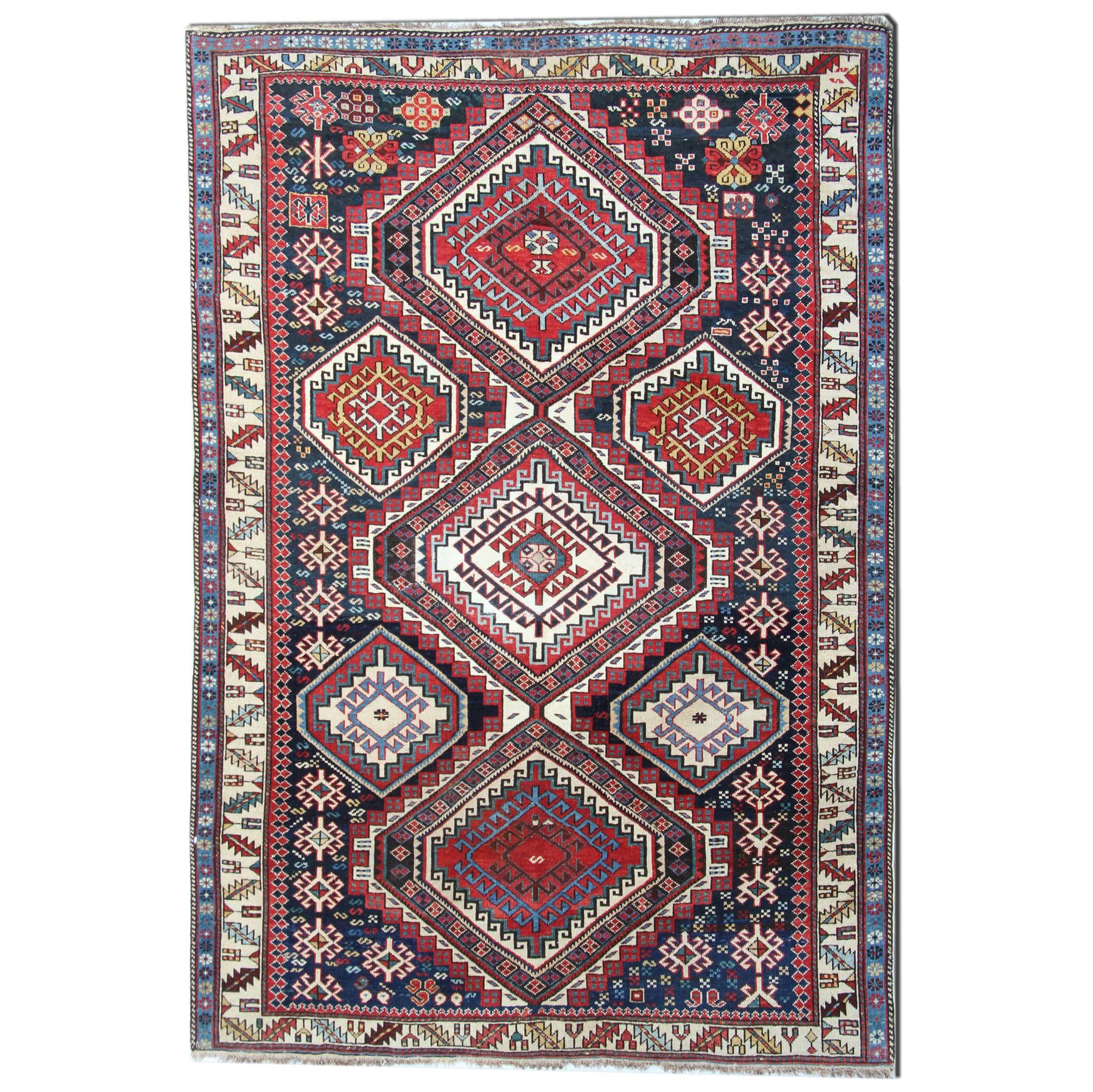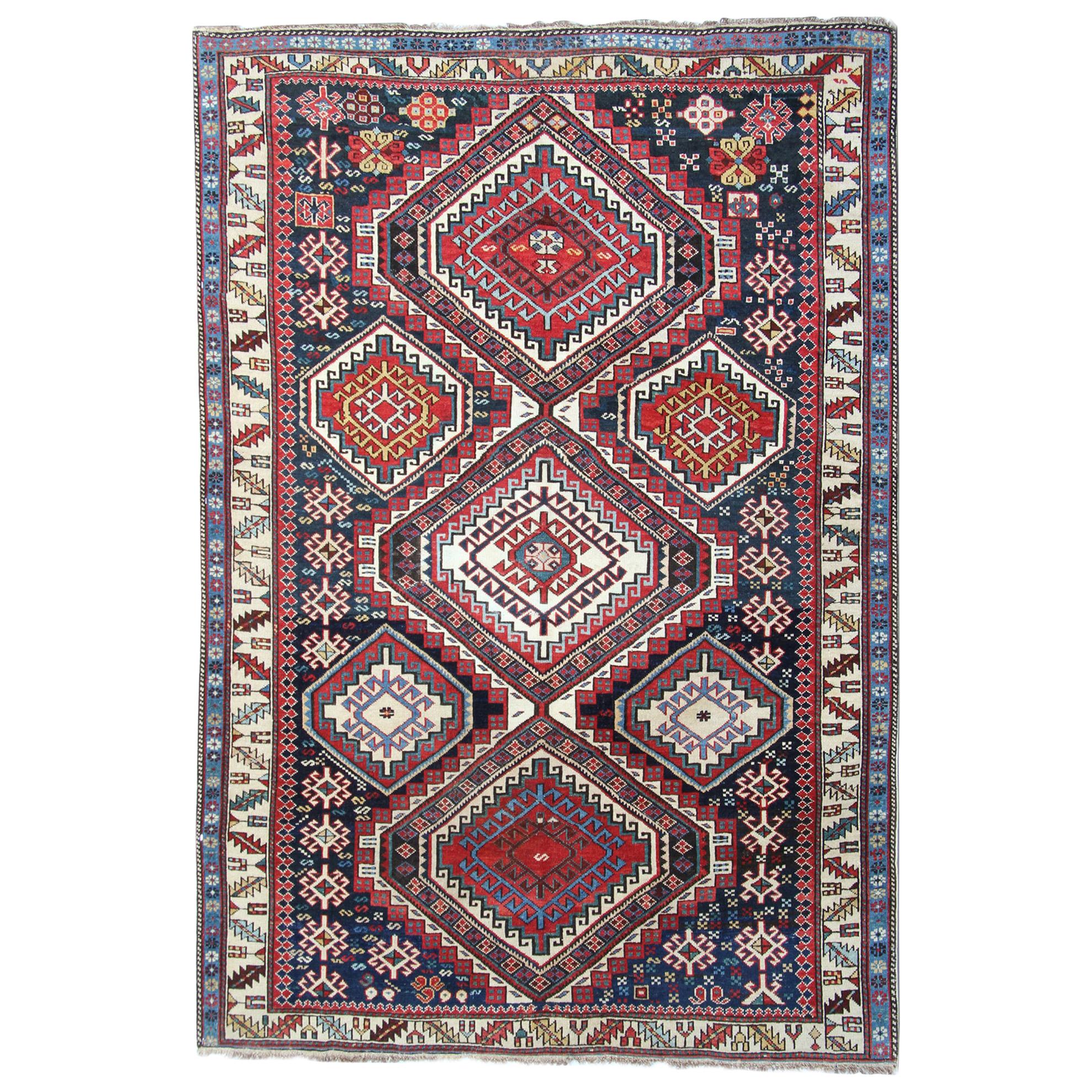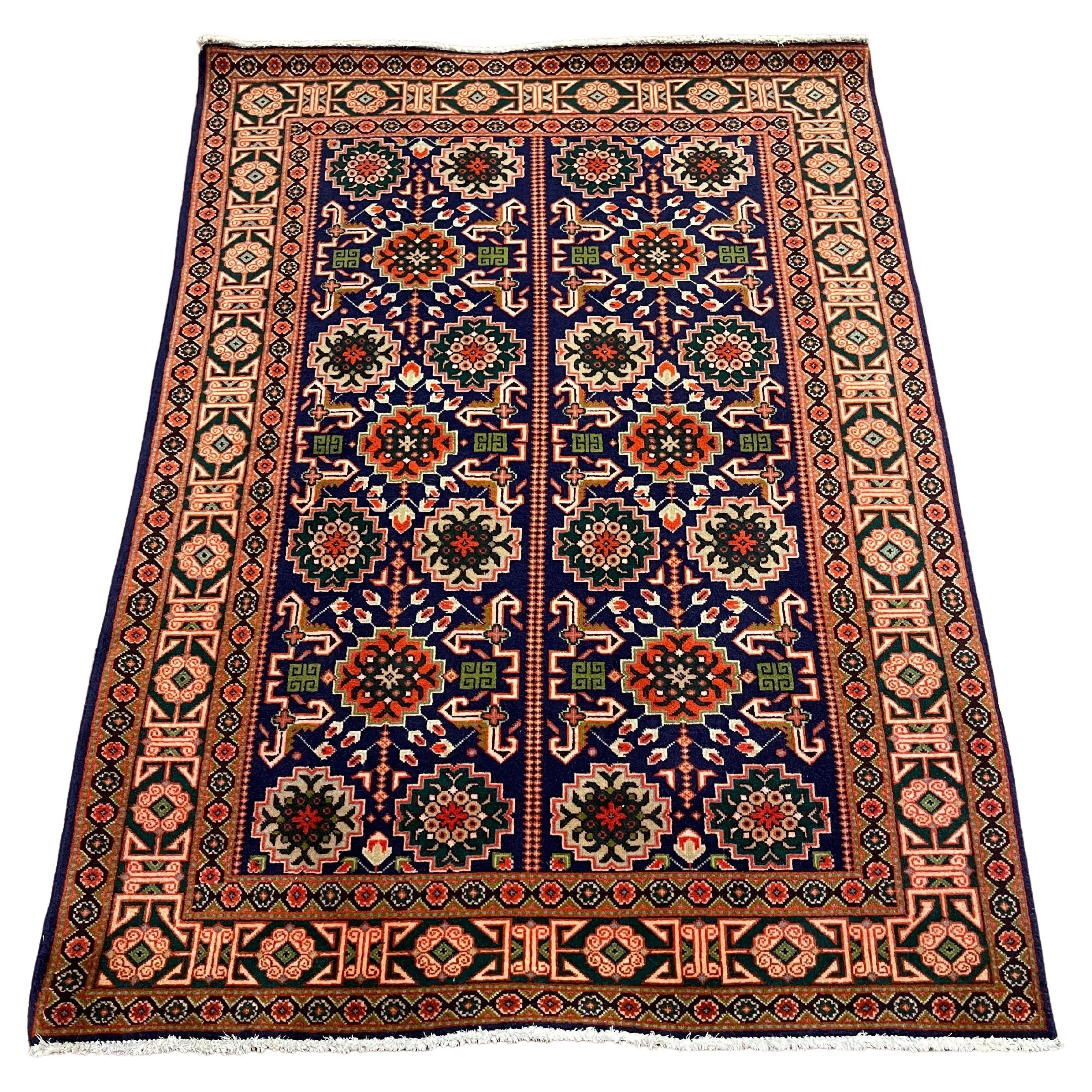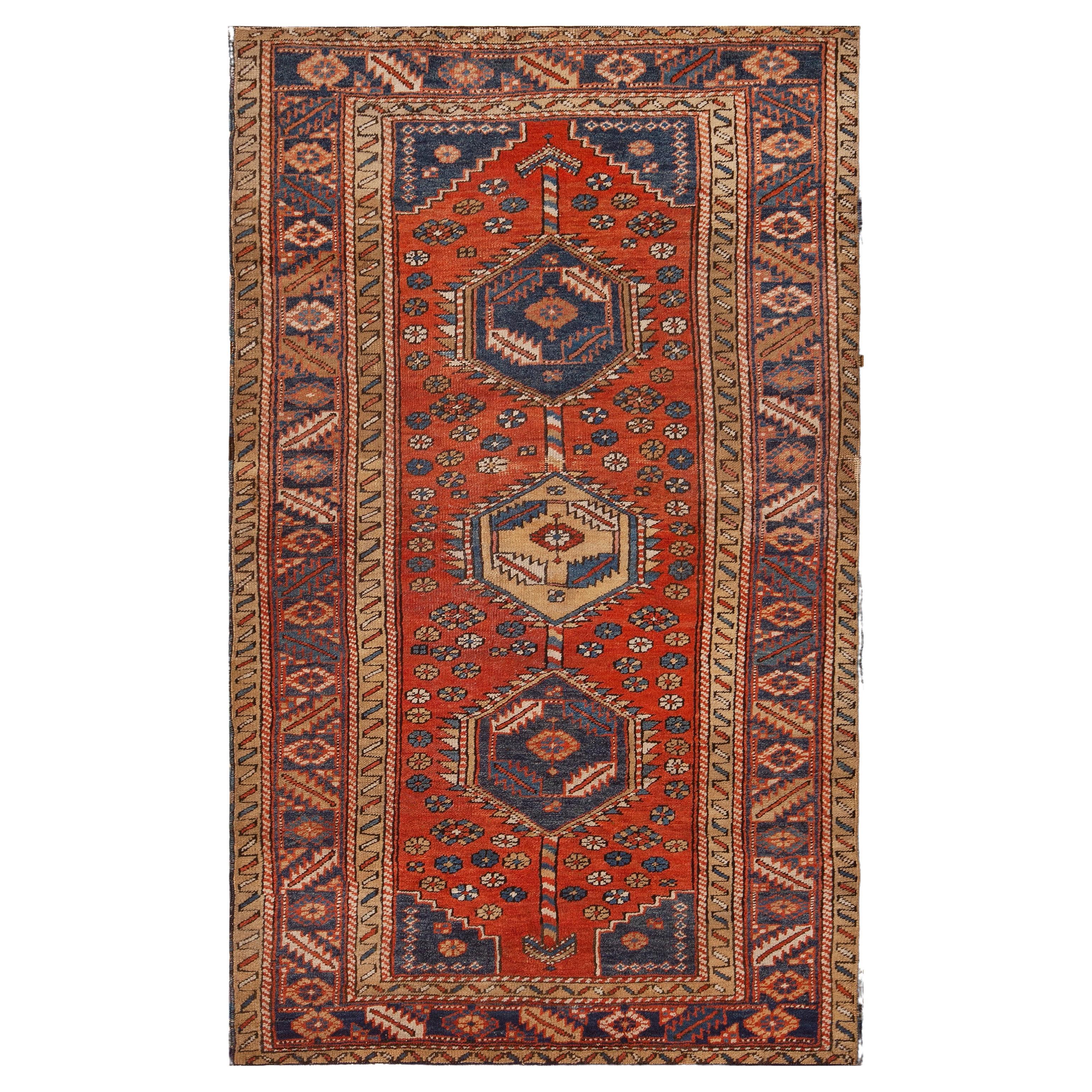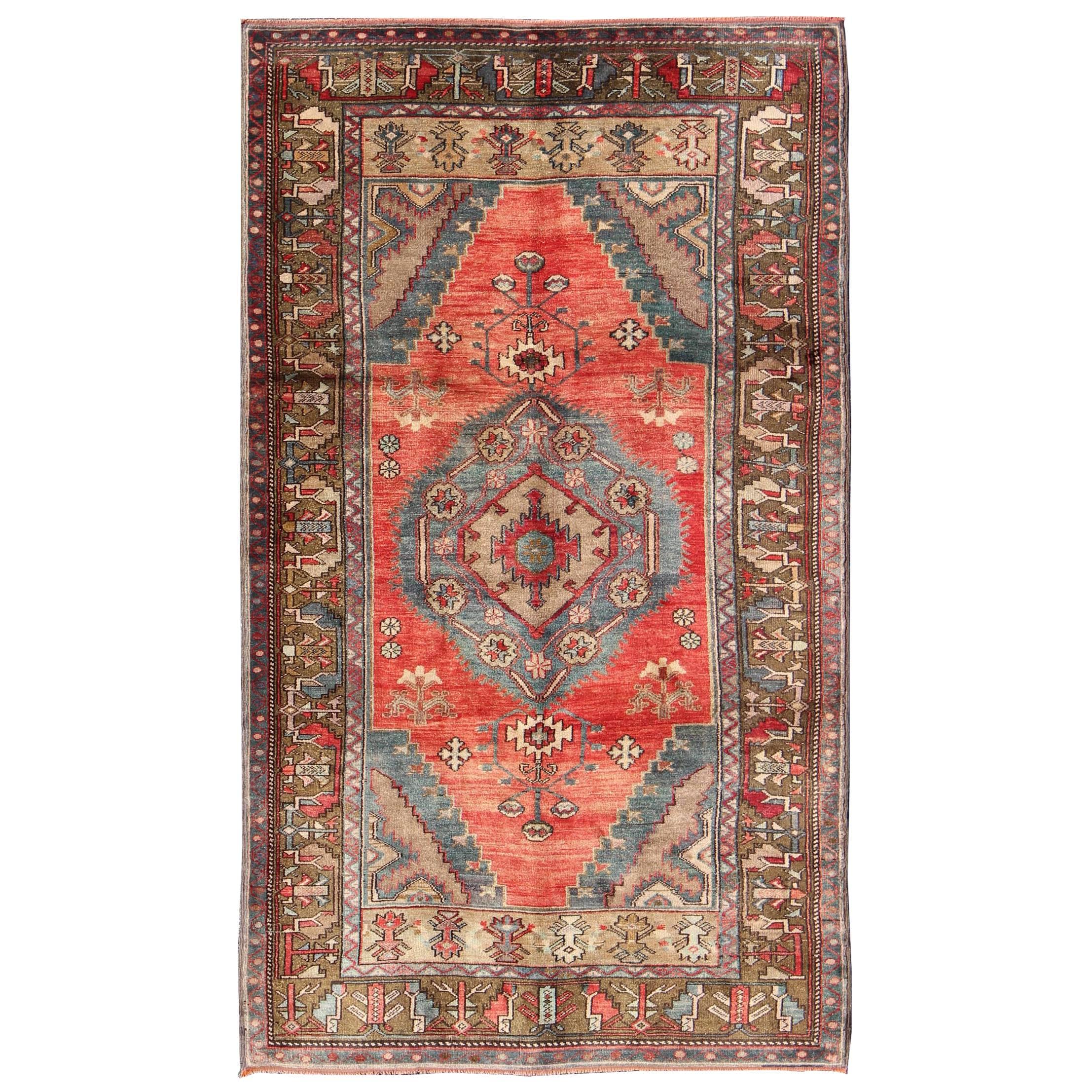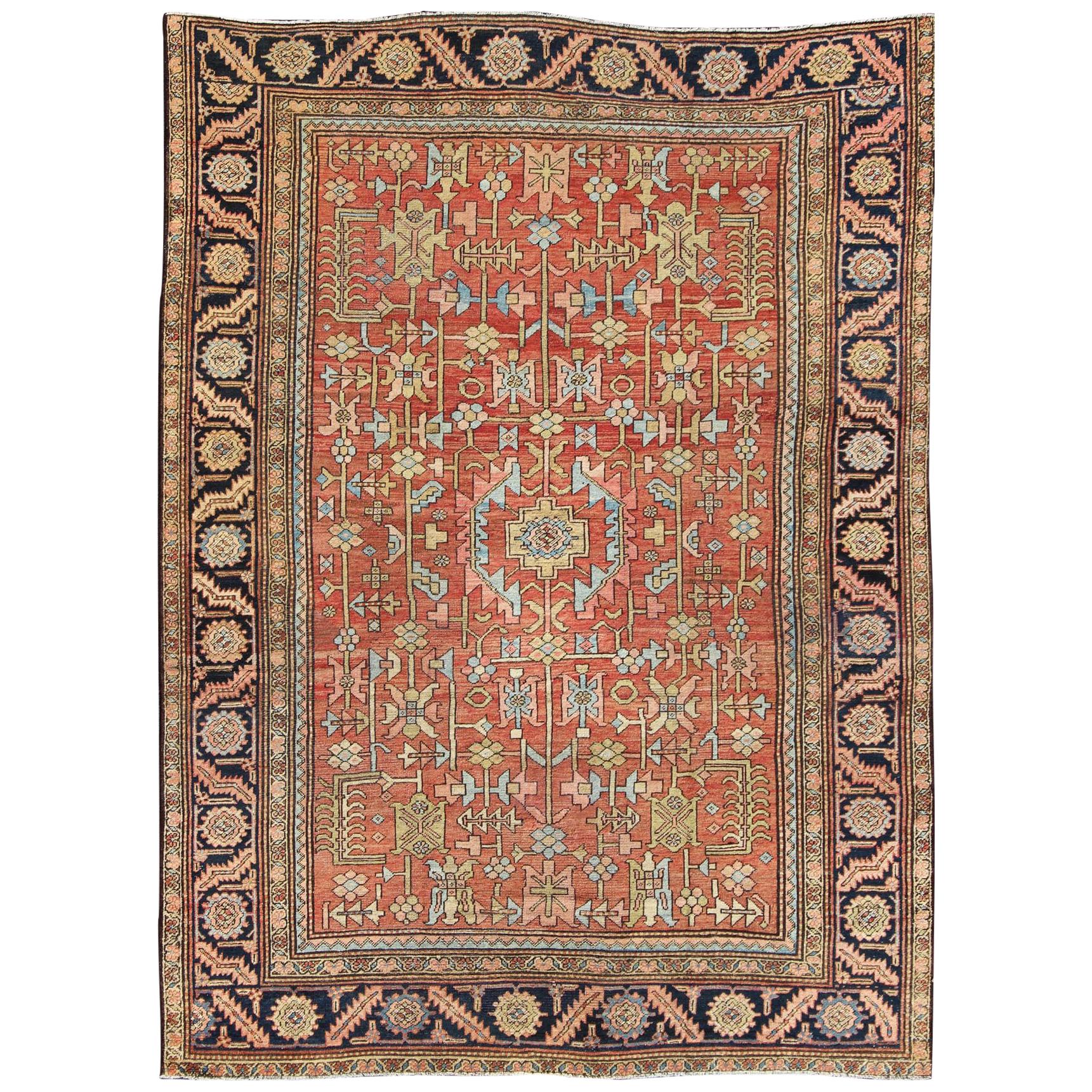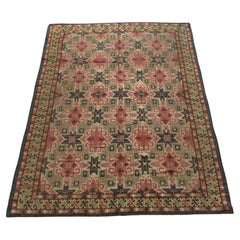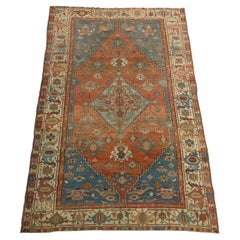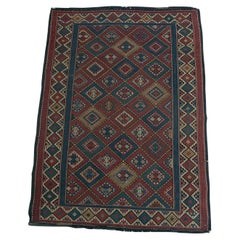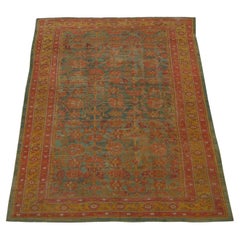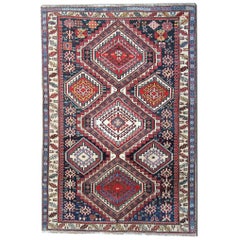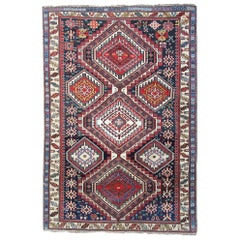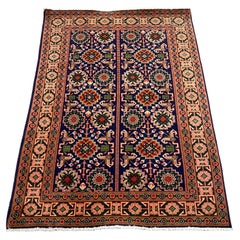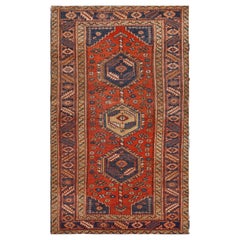Items Similar to 19th Century Geometric Tribal Serapi Heriz Tabriz Rug
Want more images or videos?
Request additional images or videos from the seller
1 of 5
19th Century Geometric Tribal Serapi Heriz Tabriz Rug
$21,750
£16,440.31
€18,892.83
CA$30,286.74
A$33,692.76
CHF 17,662.17
MX$411,717.28
NOK 224,905.65
SEK 211,717.56
DKK 141,027.83
Shipping
Retrieving quote...The 1stDibs Promise:
Authenticity Guarantee,
Money-Back Guarantee,
24-Hour Cancellation
About the Item
The village of Heriz is located just east of Tabriz in the Persian occupied part of Azerbaijan. Heriz carpets are mostly distinguished by their rectilinear designs, a departure from the traditional arabesques and scrolls typical of Persian manufactory.
A large central stepped medallion with corners or an all over design of highly stylized floral motifs is quite typical. Repeating patterns are less common. The pile is thick and heavy and the color palette is rich and varied. Older Heriz rugs had madder grounds and medallions mostly of indigo. The finer rugs use the technique “double outlining”, where the design of the rug is separated from the field by two lines in different colors. This design element sets the gold standard for the best Heriz designs.
Originating in Northwest Persia and the Iranian province of East Azerbaijan, Heriz Oriental rugs from Persia include regional patterns created in several dozen towns and villages in the area. These Azeri-Turkish groups from the Caucasus were pushed south by invading Russian and Soviet forces, and the area was subject to turbulent political influences that continued through the 20th century. Turkic nomads have produced fine carpets for export and resale since the 1700’s, and antique Heriz rugs continue to enjoy great popularity in Europe and the U.S. The Heriz moniker is applied to regional rugs originating in Ahar, Gorevan and several other prominent villages. This has lead to some confusion about these trade terms.
The city of Heriz is located roughly 60 miles from the legendary carpet-producing city of Tabriz. Although they are closely related in some respects, their styles remain distinct. Antique Heriz rugs are known for their thick, strong and durable structure. Unlike many areas of Persia, rugs from Heriz are made with the symmetric Turkish or Ghiordes knot, which is attached to a specially woven foundation that includes a thick cotton warp and weft. The structure is only one factor that contributes to the durability and stability of antique rugs from Heriz, which differ from their cousins, the Serapi Rugs and the Bakshaish rugs. Further, some carpets from this region are referred to as Heriz Serapi rugs. Tucked into the foothills surrounding the historically active volcano Mount Sabalan, Heriz sits on top of rich mineral reserves and some of the largest copper deposits in the world. Pastoral nomads known as the Shahsavan migrated across the area moving closer to Mount Sabalan in the summer and further away during the harsh winters. The result is extremely durable wool containing trace amounts of copper that act as a natural mordant and dye fixative.
Since the early 19th century, Heriz has been producing European-sized carpets that define the angular style of northwest Persian rugs. These classically colored carpets, including Serapi Heriz rugs, often feature a traditional pairing of crimson red and clear Persian blue, which are combined with varied neutrals. Heriz rugs often feature dense allover patterns and angular octofoil medallions surrounded by rectilinear vine-scrolls decorated with a rich variety of contrasting colors.
Please note, the terms Heriz and Serapi are pretty much interchangeable. Heriz rugs are among the most recognizable Persian rugs because of their distinctive geometric designs and the expressive power of their drawing.
Both the “Serapi” and Heriz rugs tend to have strong medallion designs accented through the use of color. That said, allover design Heriz rugs are not that uncommon. Heriz carpets rely on floral inspired patterns with sharp strap-work vines and grand palmettes with zig-zag contouring.
Where other antique rugs from Persia would utilize a curved form, antique Heriz rugs will apply series of angular twists and sharp straight angle turns, imparting an emphatic geometry to the rug design.
Heriz rugs have glorious color, with rich reds, blues, greens, and yellows resonating against ivory. Much of the formal vocabulary, drawing, and color sensibility of these rugs is traceable to the classical antique Caucasian rugs of the eighteenth and seventeenth centuries.
Since the Heriz region of northern Perisa is not far from the Caucasus, it is not surprising that Heriz carpets have preserved so much of the classical Caucasian tradition. Some antique Heriz rugs , however, especially those produced in silk, display a different drawing and design vocabulary linked to other types of Persian carpet. They are identified as “Heriz” rugs primarily by their weave.
Just west of Tabriz lies the village of Heriz, located in the Iranian part of Azerbaijan. Herizes are mostly distinguished by their rectilinear designs, a departure from the traditional arabesques and scrolls typical of Persian manufactory. A large central stepped medallion with corners or an allover design of highly stylized floral motifs is quite typical. Repeating patterns are less common.
The pile is thick and heavy and the color palette is rich and varied. Older Heriz rugs had madder grounds and medallions mostly of indigo. The finer antique carpets use the technique “double outlining”, where the design of the rug is separated from the field by two lines in different colors. This design element sets the gold standard for the best Heriz designs.
The Heriz style of is a paradigm for the traditional geometric designs of Northwest Persia. These distinctive rugs are woven with tribal weaves which accentuates the angles and boldness exhibited in the highly stylized floral motifs.
Typically these traditional Oriental area rugs carry a masculine aura to them. As far as interior design goes, this feature makes them perfect options for libraries, studies, and other rooms rich with wooden or earthy accents though they are also popular in living rooms both formal and non.
- Dimensions:Width: 106 in (269.24 cm)Length: 171 in (434.34 cm)
- Style:Tabriz (In the Style Of)
- Materials and Techniques:
- Place of Origin:
- Period:
- Date of Manufacture:1900s
- Condition:Wear consistent with age and use.
- Seller Location:Los Angeles, US
- Reference Number:Seller: 4715y1stDibs: LU9020235345182
About the Seller
5.0
Platinum Seller
Premium sellers with a 4.7+ rating and 24-hour response times
Established in 1920
1stDibs seller since 2023
63 sales on 1stDibs
Typical response time: <1 hour
- ShippingRetrieving quote...Shipping from: Los Angeles, US
- Return Policy
Authenticity Guarantee
In the unlikely event there’s an issue with an item’s authenticity, contact us within 1 year for a full refund. DetailsMoney-Back Guarantee
If your item is not as described, is damaged in transit, or does not arrive, contact us within 7 days for a full refund. Details24-Hour Cancellation
You have a 24-hour grace period in which to reconsider your purchase, with no questions asked.Vetted Professional Sellers
Our world-class sellers must adhere to strict standards for service and quality, maintaining the integrity of our listings.Price-Match Guarantee
If you find that a seller listed the same item for a lower price elsewhere, we’ll match it.Trusted Global Delivery
Our best-in-class carrier network provides specialized shipping options worldwide, including custom delivery.More From This Seller
View All1900 Turkish Geometric Design Rug 6'7''x 10'
Located in Los Angeles, US
Ca.1900 Turkish Oushak Stylish Geometric Design 6'7''x10'
Category
Antique Early 1900s Unknown Kilim Turkish Rugs
Materials
Wool, Cotton
Late-19th Century Persian Heriz Serapi Carpet
Located in Los Angeles, US
Antique Heriz Carpets Serapi Rugs and Persian Bakshaish Carpets – The carpets of northwest Persia are in a class of their own. Prized for their strong geometric style, fine construct...
Category
Antique 1880s Persian Tabriz Persian Rugs
Materials
Wool, Cotton
1920 Antique Geometric Sumak Flat Weave Rug
Located in Los Angeles, US
Soumak rugs (also spelled Sumak) – This construction technique produces a flat-weave rug that is thick, strong and exceptionally durable. Unlike kilims, Soumak rugs are not reversibl...
Category
Vintage 1920s Azerbaijani Empire Persian Rugs
Materials
Wool, Cotton
19th Century Tribal Turkish Oushak Rug 15'2" X 10'0"
Located in Los Angeles, US
Antique Turkish Oushak rugs have been woven in Western Turkey since the beginning of the Ottoman period. Historians attributed to them many of the great masterpieces of early Turkish...
Category
Antique 19th Century Turkish Oushak Turkish Rugs
Materials
Wool, Cotton
Antique Persian Bakhtiar Rug With Geometric Medallion - 16'5'' X 10'8''
Located in Los Angeles, US
Antique Persian Bakhtiari rugs are among the more intriguing and distinct styles of antique Persian rugs, boasting a fascinating historical heritage and expressing a unique aesthetic...
Category
1990s Unknown Tribal Persian Rugs
Materials
Wool, Cotton
1900s Antique Bochara Rug
Located in Los Angeles, US
1900s Antique Tribal Bochara Rug, handmade and hand-knotted
Category
Antique Early 1900s Afghan Tribal Turkish Rugs
Materials
Wool, Cotton
You May Also Like
Antique Turkish Shirvan Rug, Geometric Handmade Carpet Rug
Located in Wembley, GB
The Shirvan nomads are found in the Caucasia. The carpets have a typical red-brown ground colour. The pattern is tied from memory and often consists of medallions, repeated in all fo...
Category
Antique 1880s Caucasian Kazak Caucasian Rugs
Materials
Organic Material, Cotton, Wool
Antique Caucasian Shirvan Rug, Geometric Oriental Rug
Located in Wembley, GB
The Shirvan nomads are found in the Caucasia. The carpets have a typical red-brown ground colour. The pattern is tied from memory and often consists of medallions, repeated in all fo...
Category
Antique 1880s Caucasian Kazak Caucasian Rugs
Materials
Wool, Cotton, Organic Material
Persian All Over Geometric Tabriz Rug
Located in San Diego, CA
Introducing a stunning hand knotted Persian Tabriz rug that epitomizes quality craftsmanship and timeless beauty. Featuring an enchanting allover design known as Ghoba, this rug capt...
Category
Vintage 1970s Persian Tabriz Persian Rugs
Materials
Wool, Cotton
$1,320 Sale Price
20% Off
Beautiful Small Rustic Geometric Tribal Antique Persian Heriz Rug 3'10" x 6'5"
Located in New York, NY
Beautiful Small Rustic Geometric Tribal Antique Persian Heriz Rug, Country of origin: Persian Rugs, Circa date: 1900
Category
Early 20th Century Persian Heriz Serapi Persian Rugs
Materials
Wool
Turkish Konya Rug with Geometric Tribal Design
Located in Atlanta, GA
Turkish Konya Rug with Geometric Design rug/tu-sim-1
origin/turkey
This beautiful antique Konya carpet features a Classic medallion design. The faint red ground is home to the cen...
Category
Vintage 1920s Turkish Oushak Turkish Rugs
Materials
Wool
Antique Persian Serapi Rug with All-Over Geometric Design
Located in Atlanta, GA
All-Over Geometric Design Antique Persian Serapi Rug. Keivan Woven Arts / rug /S12-0301, country of origin / type: Iran / Kerman , circa 1890.
Measures: 9'5 x 12'8.
This antique Pe...
Category
Antique 1890s Persian Heriz Serapi Persian Rugs
Materials
Wool
More Ways To Browse
Octagonal Wood Table
Pierre Frey Fabric
Rattan Round Tables
Spanish Bar Stools
Stone And Brass Cocktail Table
Tubular Wood Table
Tulip Table Base
Used Dinnerware
Vintage Metal Bench
Vintage Vistas
Wood Box With Drawers
Barcelona Table Base
Breakfast Set
French Fluted Side Table
Large Glass Centerpiece Bowl
Large Silver Serving Spoon
Tea Jug
Used Guest Chairs
